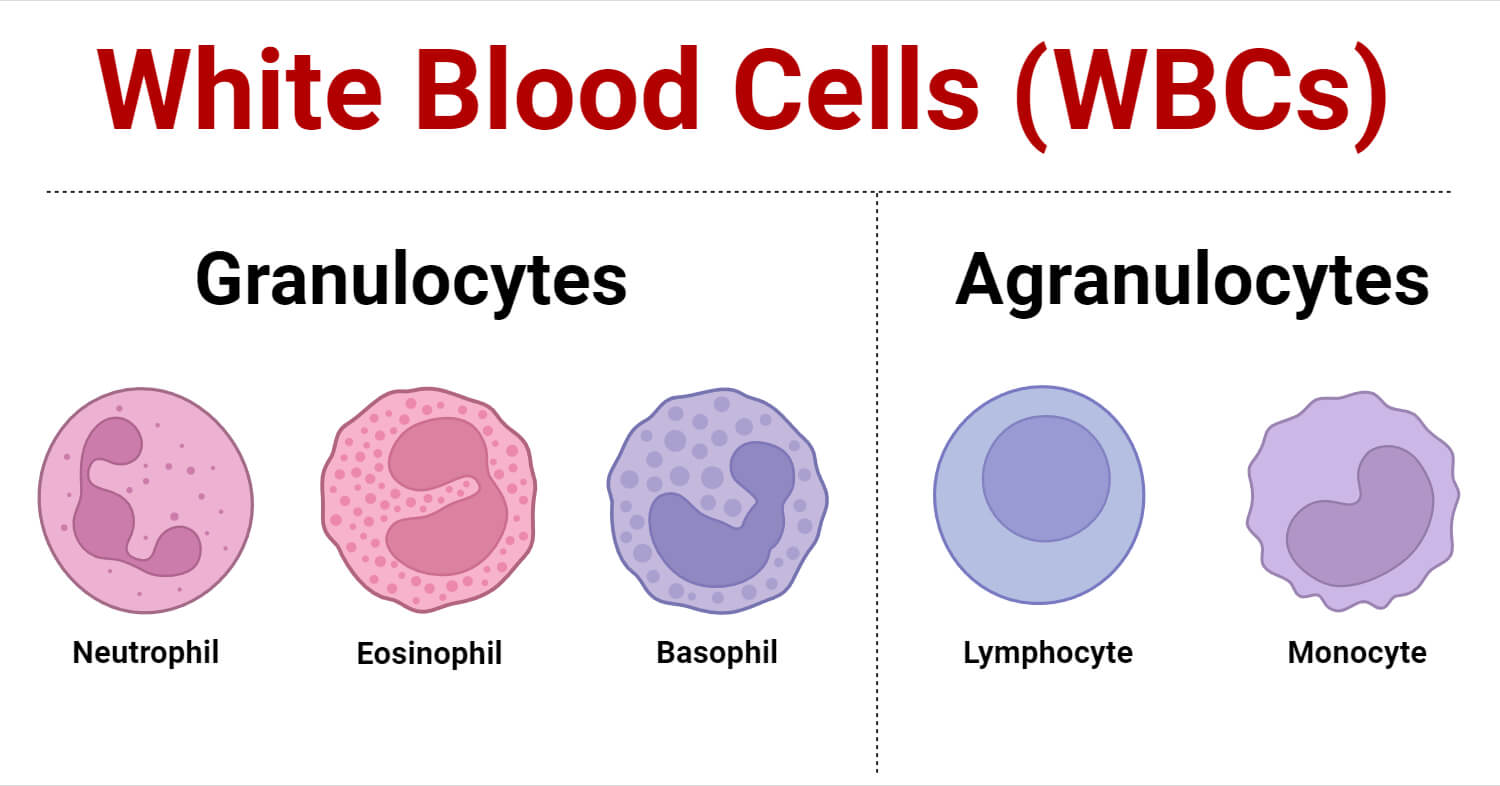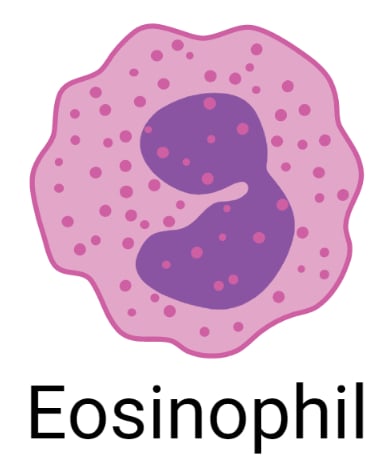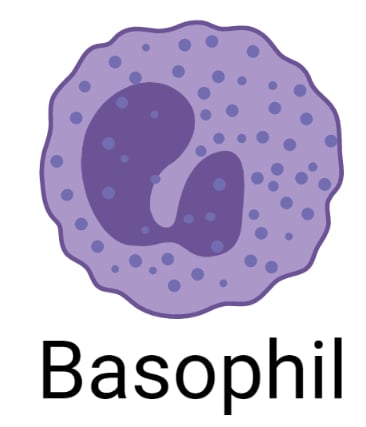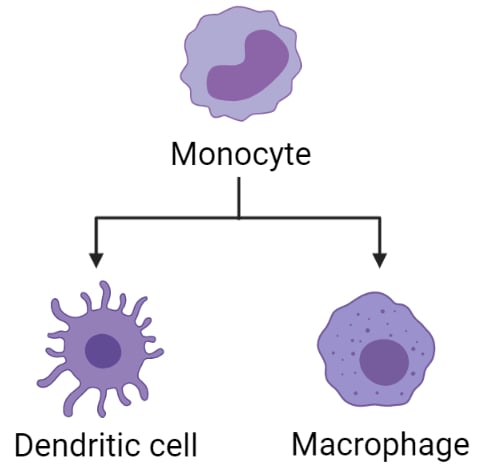White blood cells or WBCs are also known as leukocytes. WBCs are essential components of immune system as they play a crucial role in protecting the body from infections and diseases by circulating through the bloodstream and tissues to respond injury or illness.

- They are colorless cells that have a round shape with a distinct nucleus.
- They are largest blood cells but they account for 1% of the blood volume and are produced in the bone marrow.
- They have nucleus and some have granules in their cytoplasm. Due to the presence of nucleus, their metabolism is more complex as compared to that of Red Blood Cells.
- White blood cells have a unique structure that allows them to perform their function effectively.
Interesting Science Videos
Types of White Blood Cells (WBCs)
They are mainly two types: granulocytes (neutrophils, eosinophils, and basophils) and agranulocytes (monocytes and lymphocytes).
A. Granulocytes
- They are the types of white blood cells that plays an important role in innate immune responses and injuries.
- They are characterized by specific granules in their cytoplasm which contains enzymes that protects from pathogens and fight infections.
There are three types of granulocytes: neutrophils, eosinophils, and basophils.
- Each of the granulocytes have distinct functions. Neutrophils are the most abundant type, specialize in eliminating pathogens such as bacteria and viruses whereas eosinophil and basophils contribute to allergic reactions and combat parasitic infections.
- Granulocytes are produced in the bone marrow and have a short lifespan, typically living only a few days.
- The number of granulocytes in the body usually increases during serious infections, and they are counted as part of a white blood cell test.
1. Neutrophils
- They are the most plentiful white blood cells that are crucial in combating bacterial infections.
- They occupy about 40-60% of the total white blood cells counted in blood.
- They are originated from stem cells in the bone marrow, undergo differentiation, and enter the bloodstream.
- After circulating for 7 to 10 hours, neutrophils migrate into tissues, where their lifespan is limited to a few days. It has a life span of about 12-20 days.
- They have high mobility; they swiftly navigate cells and tissues during infections.
- Neutrophils can classify into two groups: neutrophil-killers and neutrophil-cagers.
- Neutrophils are integral components of the innate immune system as they are at the front lines of attack during an immune response.

2. Eosinophils
- They constitute about 1-4% of total WBCs.
- They play an important role in the elimination of parasites and in neutralizing histamine released during allergic reactions.
- It contains the protein plasminogen, which helps to dissolve blood clots.
- Eosinophil have a circulating half-life of approximately 18 hours and in tissue for at least six days.
- They are characterized by their two-lobed nucleus and large granules filled with proteins like eosinophil-derived neurotoxin (EDN), eosinophil cationic protein (ECP), and eosinophil peroxidase (EPO).
- They initiate and sustain inflammatory responses, combat parasitic infections, and manage allergic conditions. At the same time, they are mainly known for antiparasitic activity.
- They release various cytokines that support T cell functions, including proliferation, activation, and polarization, contributing to communication among immune system cells.

3. Basophils
- Basophils are originated in the bone marrow and are distributed in various tissues throughout the body.
- They have very short life span.
- They serve multiple functions including fighting parasitic infection, preventing blood clotting due to their heparin content (a natural blood-thinning substance), and mediating allergic reactions by releasing histamine and other substances like serotonin, inducing inflammation in areas exposed to allergens.
- They acts as integral components of the immune system and collaborate closely with other immune cells such as mast cells and eosinophils.
- Notably, they possess a unique characteristic since they do not recognize previously encountered pathogens but instead target any unfamiliar organisms perceived by the body.
- Basophils play a vital role in facilitating the body’s response to allergic reactions and contribute to inflammatory responses during immune reactions.

B. Agranulocytes
- They are the types of white blood cells that has distinct and specialized function in supporting and participating in immune responses.
- They are characterized by the absence of granules in their cytoplasm which include lymphocyte and monocytes that protects from pathogens and fight infections.
1. Lymphocytes
- Lymphocytes are the specialized cells that uniquely recognize and respond to foreign antigens.
- They can be identified by their large nucleus and constitute between 18-40% of circulating WBCs.
- They serves as mediators for both humoral and cellular immunity.
- There are three main types of lymphocytes. They are T-cells, B-cells and natural killer cells.
- B cells are responsible for producing antibodies to attack invading bacteria, viruses and toxins.
- T-cells plays important role in cell-mediated immunity. They destroy the body’s own cells that have been taken over by viruses or become cancerous. They can also produce cytokines, which are biological substances that helps to activate other parts of immune system.
- Natural killer cells function in cell-mediated, cytotoxic innate immunity. They can recognize changes in the level of a surface molecule called MHC (Major Histocompatibility Complex). They can release cytotoxic granules, which then destroy the altered cells.
- Their contribution is crucial as they provide a defense mechanism against diseases, infection, and foreign agents.
- They are an integral part of the immune system, and their levels can be assessed through a blood test to evaluate the body’s immune response.

2. Monocytes
- Monocytes are white blood cells that play an important role in defending the body from infections and foreign elements within the immune system.
- They are the largest among the WBCs, ranging from 15-22 µm in diameter and comprising 2% to 10% of leukocytes and 5% of the total circulating nucleated cells in human blood.
- These cells originate from monoblasts in bone marrow, deriving from hematopoietic stem cells.
- They circulate in the bloodstream for about 1 to 3 days before migrating into tissues, where they mature into larger phagocytic cells called macrophages.
- They differentiate into macrophages and dendritic cells. So, they are essential for both innate and adaptive immune systems.
- They occur in all vertebrates, but the concentration in the bloodstream differs in species.

Functions of White Blood Cells (WBCs)
- They are responsible for protecting the body from infections and diseases.
- They circulates through the bloodstream and tissues, responding to illness or injury by locating the site of an infection and notifying other white blood cells.
- They also fight invaders by producing antibodies and destroy potentially harmful microorganisms.
- They play a crucial role in the immune system, acting as the body’s defense against infections and foreign invaders.
Roles of White Blood Cells (WBCs) in Immunity
- Detection of Invaders:
- White blood cells constantly circulates the bloodstream and tissues, actively searching for signs of infection or foreign substances.
- Phagocytosis:
- Some white blood cells, such as neutrophils and macrophages, are phagocytes.
- They engulf and digest foreign particles, including bacteria and dead or damaged cells.
- This process is called phagocytosis and is a crucial mechanism in the early stages of an immune response.
- Antigen Presentation:
- White blood cells, particularly dendritic cells, play a role in antigen presentation.
- They capture antigens (molecules that trigger an immune response) and present them to other immune cells, such as T cells, to initiate a more specific and targeted immune response.
- Immune Response Coordination:
- White blood cells communicate with each other through chemical signals, ensuring a coordinated and efficient response to an infection.
- This communication helps activate and direct other components of the immune system.
- Lymphocytes:
- Lymphocytes, including T cells and B cells, are specialized white blood cells that play key roles in adaptive immunity.
- T cells are involved in cell-mediated immunity, directly attacking infected or abnormal cells, while B cells produce antibodies that can neutralize pathogens or mark them for destruction by other immune cells.
- Memory Cells:
- After an infection is cleared, some white blood cells transform into memory cells.
- These memory cells “remember” the specific pathogens they encountered.
- If the same pathogen reappears, the immune system can mount a faster and more effective response, providing immunity.
- Regulation of Immune Responses:
- White blood cells help regulate the immune response to prevent excessive inflammation and tissue damage.
- Regulatory T cells, for example, suppress immune reactions to maintain balance and prevent autoimmune responses.
References
- Waugh A & Grant A (2018). Ross & Wilson anatomy and physiology in health and illness (13th edition).
- PERRY S, CRADDOCK CG, PAUL G, LAWRENCE JS. Lymphocyte Production and Turnover. AMA Arch Intern Med. 1959;103(2):224–230. doi:10.1001/archinte.1959.00270020052006
- Tigner A, Ibrahim SA, Murray IV. Histology, White Blood Cell. [Updated 2022 Nov 14]. In: StatPearls [Internet]. Treasure Island (FL): StatPearls Publishing; 2024 Jan-. Available from: https://www.ncbi.nlm.nih.gov/books/NBK563148/
- Min B, Brown MA, Legros G. Understanding the roles of basophils: breaking dawn. Immunology. 2012;135(3):192-197. doi:10.1111/j.1365-2567.2011.03530.x
- Professional, C. C. M. (n.d.). Granulocytes. Retrieved from https://my.clevelandclinic.org/health/body/22016-granulocytes
- Lymphocytes. (n.d.). Retrieved from https://www.physio-pedia.com/Lymphocytes
- What are white blood cells? – Health Encyclopedia – University of Rochester Medical Center. (n.d.). Retrieved from https://www.urmc.rochester.edu/encyclopedia/content.aspx?ContentID=35&ContentTypeID=160
- WebMD Editorial Contributor. (2023, September 20). What are lymphocytes? Retrieved from https://www.webmd.com/a-to-z-guides/what-are-lymphocytes
- The Editors of Encyclopaedia Britannica. (2024, April 12). Neutrophil | Description, Characteristics, & Function. Retrieved from https://www.britannica.com/science/neutrophil
